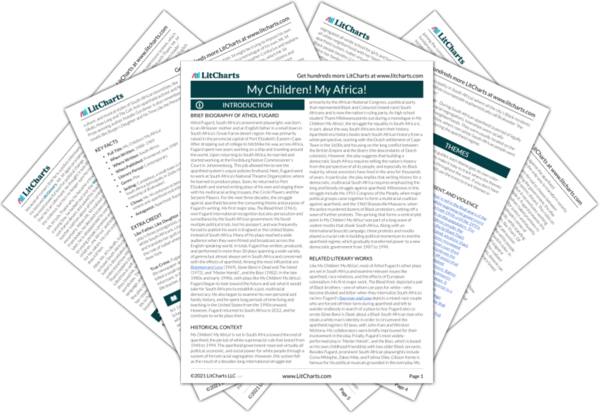Welcome to the LitCharts study guide on Athol Fugard's My Children! My Africa!. Created by the original team behind SparkNotes, LitCharts are the world's best literature guides.
My Children! My Africa!: Introduction
My Children! My Africa!: Plot Summary
My Children! My Africa!: Detailed Summary & Analysis
My Children! My Africa!: Themes
My Children! My Africa!: Quotes
My Children! My Africa!: Characters
My Children! My Africa!: Terms
My Children! My Africa!: Symbols
My Children! My Africa!: Theme Wheel
Brief Biography of Athol Fugard

Historical Context of My Children! My Africa!
Other Books Related to My Children! My Africa!
- Full Title: My Children! My Africa!
- When Written: 1988–1989
- Where Written: South Africa
- When Published: Premiered June 1989
- Literary Period: Contemporary
- Genre: Play
- Setting: Camdeboo, a small town in the Great Karoo desert, South Africa (principally in Zolile High School in the Black township of Brakwater)
- Climax: Mr. M confesses to being a police informant, and a violent anti-apartheid mob kills him.
- Antagonist: Apartheid; Racism
Extra Credit for My Children! My Africa!
Like Father, Like Daughter. Fugard based Isabel, one of the play’s three protagonists, on his daughter Lisa. Like many young white South Africans, Lisa struggled to make sense of apartheid and translate her guilt into political action. In fact, Lisa played the role of Isabel when it was first performed in London and New York.
True Crime. Fugard based the story of Mr. M’s death on a real-life newspaper article: during an anti-apartheid protest, a mob killed a small-town schoolteacher, allegedly for being a police informant. In fact, Fugard named his character after this real-life teacher, Anela Myalatya.












